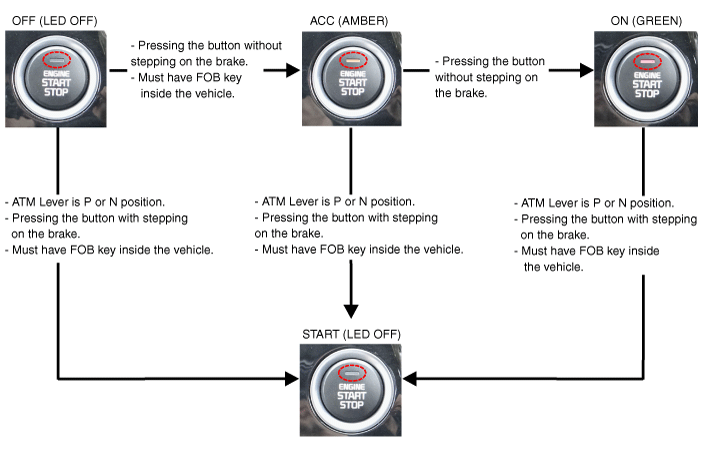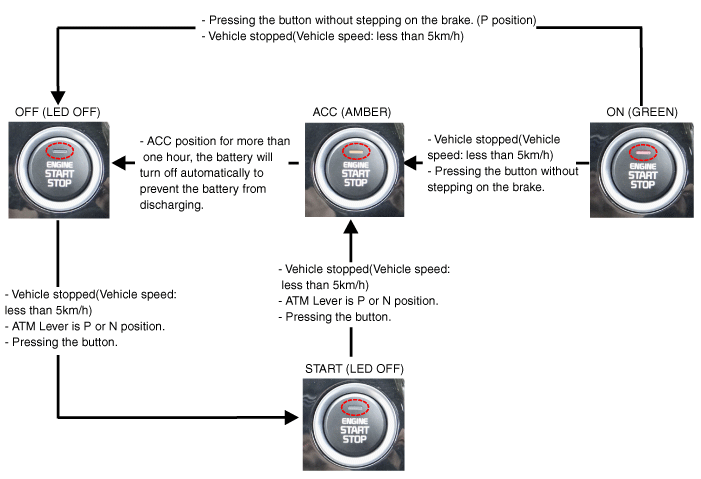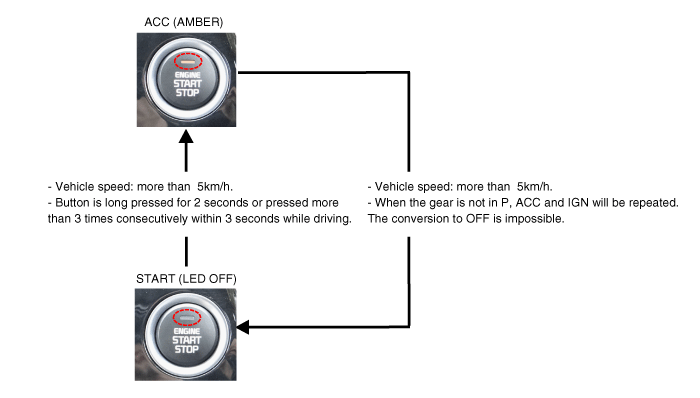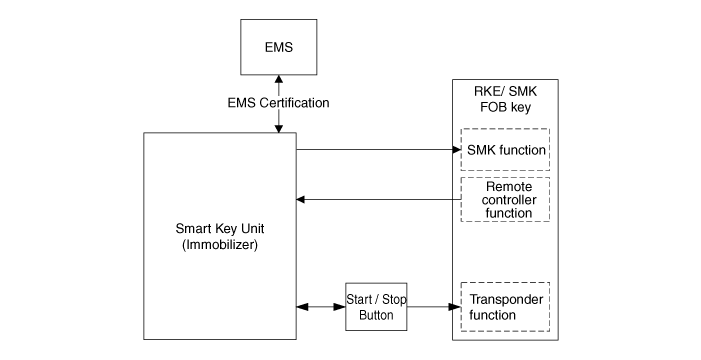Kia Forte: Body Electrical System / Button Engine Start System
Components and components location
| Components |
| [4DR] |
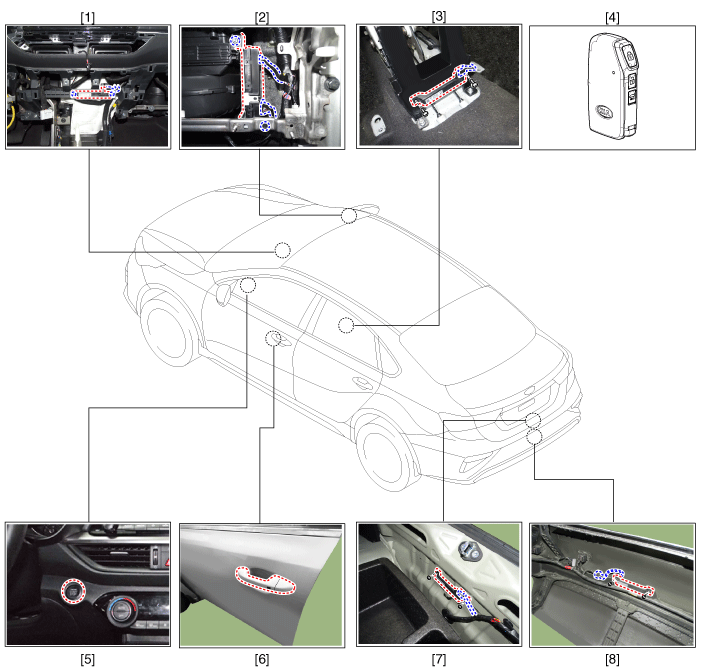
| 1. Interior antenna 1 2. Integrated body control unit (IBU) 3. Interior antenna 2 4. FOB Key |
5. Start stop button (SSB)
6. Door & handle antenna 7. Trunk antenna 8. Bumper antenna |
| [5DR] |
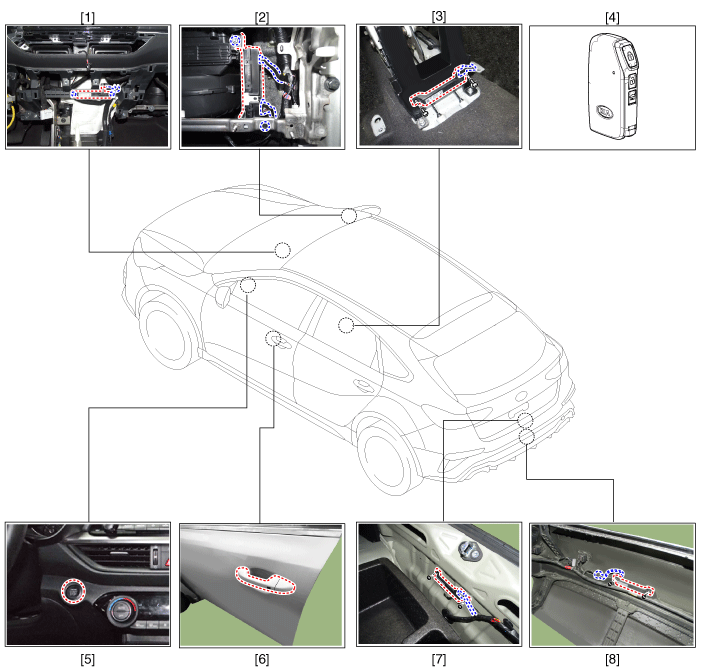
| 1. Interior antenna 1 2. Integrated body control unit (IBU) 3. Interior antenna 2 4. FOB Key |
5. Start stop button (SSB)
6. Door & handle antenna 7. Trunk antenna 8. Bumper antenna |
Description and operation
| Description |
System Overview
The System offers the following features:
| – |
Changing the state of engine ignition and power by using the start button. |
| – |
Controlling external relays for ACC / IGN1 / IGN2 terminal switching and STARTER, without use of mechanical ignition switch. |
| – |
Indicating the vehicle status on display by using LED or explicit messages. |
| – |
Immobilizer function by LF transponder communication between fob and fob holder. |
| – |
Redundant architecture for high system dependability. |
| – |
Interface with Low Speed CAN vehicle communication network. |
| – |
Interface with LIN vehicle communication network depending on platform . |
The RKE and SMART KEY functions are not considered part of this Button Engine Start system and are specified in a separate system.
System Main Function
| – |
Switching of ACC / IGN1 / IGN2 terminals. |
| – |
Control of the STARTER relay BAT line (high side) based on communication with EMS ECU. |
| – |
Management of the Immobilizer function. |
| – |
Management of BES warning function. |
Button Engine Start System
The Button Start System allows the driver to operate the vehicle by simply pressing a button (called as SSB) instead of using a standard mechanical key.
If the driver presses the SSB while prerequisites on brakes, fob authentication and transmission status are satisfied, the BES System will proceed with the locking/unlocking of the steering column, the control of the terminal, and the cranking of the engine.
The driver can release the SSB as soon as this sequence is initiated. After positive response from immobilizer interrogation, the system will activate the starter motor and communicate with the EMS to check the engine running status for starter release.
The driver will be able to stop the engine by a short push on the SSB if the vehicle is already in standstill. Emergency engine stop will be possible by a long press of the SSB or 3 consecutive presses in case the vehicle is in ENGINE RUNNING.
If the conditions for engine cranking are not satisfied while a push on the SSB is detected and a valid fob authenticated, the system will unlock the steering column and switch the terminals to IGN. Another push on the SSB will be necessary to start the engine.
In case of a vehicle equipped with SMART KEY system, fob authentication will not require any action from the driver. For limp home start or in case of vehicle without SMART KEY, the driver will have to insert the fob into the fob holder.
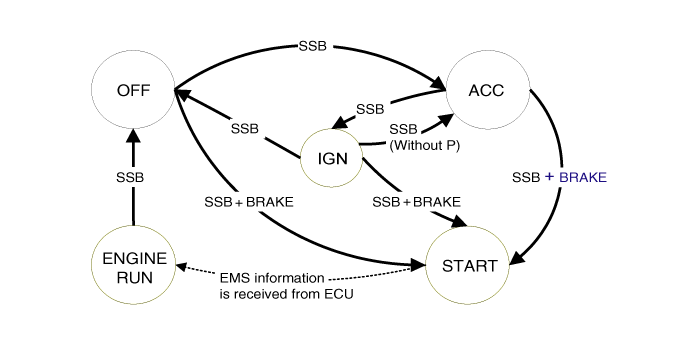
Remark :
| 1. |
This condition is shown only when it is general situation for button engine starting. |
| 2. |
This conditin is when the certification is valid. |
| 3. |
The movement can be different depanding on the position of transmission lever.
|
Operation for each function of button starting
| 1. |
Electric power ON / Ignition ON
|
| 2. |
Electric power OFF/ Ignition OFF
|
| 3. |
How to force the ignition off and to restart during driving
|
| 4. |
Function of 0.5 second delay for brake switch input. The starting is available when the brake pedal is stepped on within 0.5 second after pressing the start button in engine OFF state. |
| 5. |
State of start button indicator (LED) ON depending on the electric power state.
|
Wireless Communications
The electric wave is used to exchange information between vehicle and FOB key. For now, button engine start is applied with smart key FOB key together.
Smart key function is explained separately so refer to the correspoding system contents.
Main Functions
| • |
ACC / IGN1 / IGN2 Terminal switch |
| • |
Starter relay control (Communication with the EMS ECU) |
| • |
Immobilizer function management |
| • |
Button engine start system (BES) alert functions management |
System Block Diagram
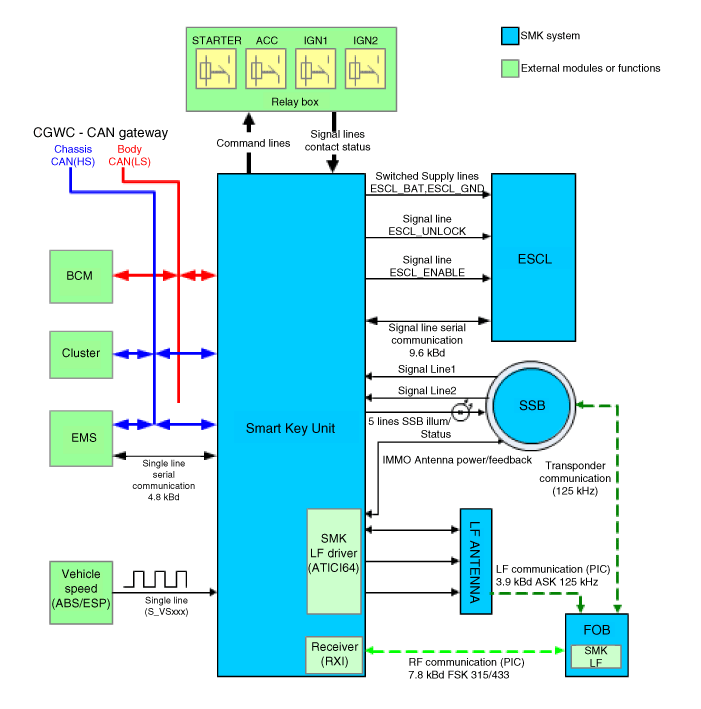
Refer to the " Smart Key System" for the block diagram and circuit diagram of the smart key unit.
|
Smart Key Unit
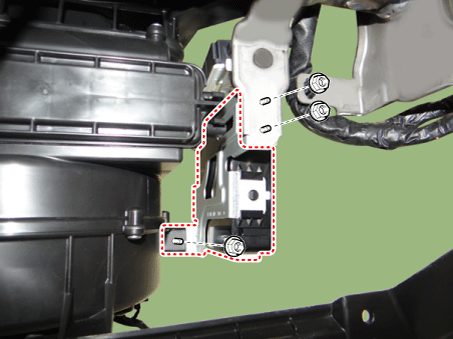
The SMK manages all functions related to:
| • |
"Start Stop Button (SSB) monitoring", |
| • |
"Immobilizer communication" (with Engine Management System unit for releasing immobilizer), |
| • |
"Authentication server" (Validity of Transponder and in case of Smart Key option Passive Fob authentication ), |
| • |
"System consistency monitoring", |
| • |
"System diagnosis", |
| • |
Control of display message / warning buzzer . |
The unit behaves as the master of the whole system.
In case of SMART KEY application, for example "Passive Access”, "Passive Locking” and "Passive Authorization" are integrated to "Terminal switching Operations”.
It collects information about vehicle status from other modules (vehicle speed, alarm status, driver door open...), reads the inputs (e.g. SSB, Capacitive Sensor / Lock Button, PARK position Switch), controls the outputs (e.g. exterior and interior antennas), and communicates with others devices via the CAN network as well as a single line interfaces.
The diagnosis and learning of the components of the BES System are also handled by the SMK.
The SMK manages the functions related to the "terminal control" by activating external relays for ACC, IGN1 and IGN2. This unit is also responsible for the control of the STARTER relay.
The SMK also controls the illumination of the SSB as well as the "system status indicator", which consists of 2 LEDs of different colors. The illumination of the fob holder is also managed by the SMK.
The SMK reads the inputs (Engine fob in, vehicle speed, relays contact status), controls the outputs (Engine relay output drivers), and communicates with other devices via the CAN.
The internal architecture of the SMK is defined in a way that the control of the terminal is secured even in case of failure of one of the two microcontrollers, system inconsistency or interruption of communication on the CAN network.
In case of failure of one of the two controllers, the remaining controller shall disable the starter relay. The IGN1 and IGN2 terminal relays shall be maintained in the state memorized before the failure and the driver shall be able to switch those IGN terminals off by pressing the SSB with EMERGENCY_STOP pressing sequence. However, engine restart will not be allowed. The state of the ACC relay will depend on the type of failure.
The main functions of the SMK are:
| • |
Control of Terminal relays |
| • |
Monitoring of the Vehicle speed received from sensor or ABS/ESP ECU. |
| • |
Control of SSB LEDs (illumination, clamp state). |
| • |
Control of the base station located in SSB through direct serial interface. |
| • |
System consistency monitoring to diagnose SMK failure and to switch to relevant limp home mode. |
| • |
Providing vehicle speed information |
| • |
Start Stop Button (SSB) monitoring |
| • |
Starter power control |
Limp Home mode
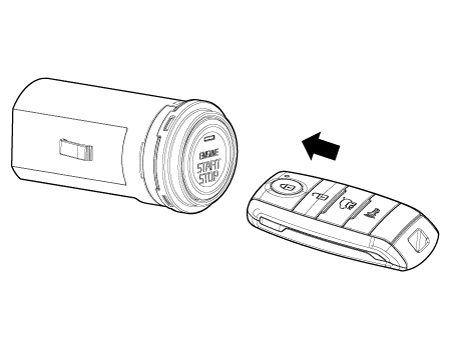
| – |
In case of no input signal for the brake (AT specification), the ACC mode shall move to “START” by pressing SSM for more than 10 seconds. |
| – |
In case of problems with communication between EMS and CAN (the EMS state). the “START” state moved to the “ENGINE RUN” based on RPM input. |
| – |
In case that one out of two SSM input lines is disconnected, The electric power cycling is available when SSB is pressed twice within 10 seconds (SSB LIMP HOME PRESS) The buzzer rings when the button is pressed in the first time. The electric power cycling is available and buzzer stops when the button is pressed twice within 10 seconds. |
Terminal and Starter Relay
Relay is used to switch the terminal ACC / IGN1 / IGN2. Normally-open relay is operated by smart key unit.
One relay coil is connected to output terminal of smart key unit.
Start/Stop Button (SSB)
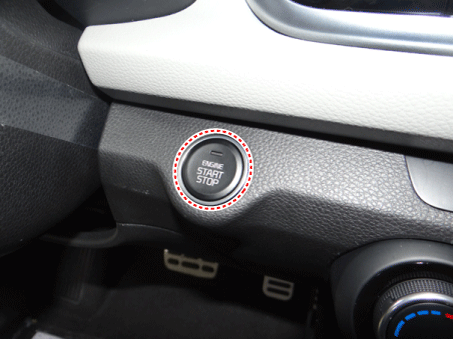
A single stage push button is used for the driver to operate the vehicle. Pressing this button allows:
| • |
To activate the power modes ‘Off’, ’Accessory’, ‘Ignition’ and 'Start' by switching the corresponding terminals |
| • |
To start the engine |
| • |
To stop the engine |
The contact will be insured by a micro-switch and a backlighting is provided to highlight the marking of the button whenever necessary.
Three (3) LED colors are located in the outside ring of the switch assy. They display the status of the system.
They are OFF(White) / ACC(Amber) / ON(Green).
Electronic Steering Column Lock (ESCL)
The ESCL is needed to lock the steering column in order to prevent unauthorized usage of the vehicle. In order to achieve the required safety integrity level, the ESCL is controlled and monitored by the SMK. Such redundant architecture guarantees that the ESCL motor is supplied only during locking/unlocking operation and that it is disconnected from the battery and ground lines otherwise to avoid unexpected operation while the vehicle is in motion.
Data are exchanged between the ESCL and SMK through an encrypted serial communication interface.
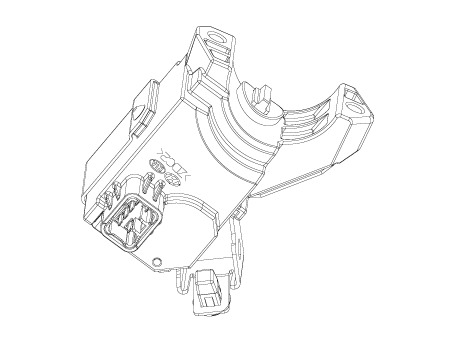
BES System State Chart
| System STATES in LEARNT MODE |
In learnt mode, the BES System can be set in 6 different sates, depending on the status of the terminals, ESCL and Engine status:
|
System State |
Terminal Status |
ESCL Status |
Engine status |
|
1. OFF - Locked |
OFF |
Locked |
Stopped |
|
2. OFF - Unlocked |
OFF |
Unlocked |
Stopped |
|
3. ACC |
ACC |
Unlocked |
Stopped |
|
4. IGN |
IGN1, IGN2, ACC |
Unlocked |
Stopped |
|
5. Start |
IGN1, Start |
Unlocked |
Cranking |
|
6. IGN - Engine |
IGN1, IGN2, ACC |
Unlocked |
Running (means "self-running") |
Referring to the terminals, the system states described in the table above are same as those one found in a system based on a mechanical ignition switch. The one of distinction with Mechanical-Ignition-Switch based system is that the BES system allows specific transition from [OFF] to [START] without going through [ACC] and [IGN] states.
System STATES IN VIRGIN MODE
The BES System can be set in 5 different states (OFF LOCKED is not available in virgin mode), depending on the status of the terminals, ESCL and Engine status:
|
System State |
Terminal Status |
ESCL Status |
Engine status |
|
1. OFF - UNLOCKED |
OFF |
Unlocked |
Stopped |
|
2. ACC |
ACC |
Unlocked |
Stopped |
|
3. IGN |
IGN1, IGN2, ACC |
Unlocked |
Stopped |
|
4. Start |
IGN1, START with special pattern of activation see Chap 6.2.1 for details
|
Unlocked |
Cranking |
|
5. IGN - Engine |
IGN1, IGN2, ACC |
Unlocked |
Running (means "self-running") |
Referring to the terminals, the system states described in the table above are same as those one found in a system based on a mechanical ignition switch. The one of distinction with Mechanical-Ignition-Switch based system is that the BES system allows specific transition from [OFF] to [START] without going through [ACC] and [IGN] states.
 Blind-Spot Radar Warning Indicator
Blind-Spot Radar Warning Indicator
Repair procedures
Removal
1.
Disconnect the negative (-) battery terminal.
2.
Remove mirror (A) to the direction as shown in the picture using (- ...
 Start/Stop Button
Start/Stop Button
Schematic diagrams
Connector and Terminal function
Repair procedures
Removal
1.
Disconnect the negative (-) battery terminal.
2.
R ...
Other information:
Kia Forte 2019-2025 (BD) Service Manual: Airbag Module
The airbag module disposal procedure The airbag module disposal procedure If equipped with an airbag to scrapping the equipment, such as airbags and safety belt pretensioners deploy a vehicle airbag device should be sure first. In addition, when to deploy the air bag device and to ...
Kia Forte 2019-2025 (BD) Owners Manual: Operating conditions to operate
• Go to “User Settings → Driving Assist and select Rear Cross Traffic Collision Warning” on the LCD display. The system will turn on and standby to activate. If you deactivate this function in the cluster, the system will stop. ✽ NOTICE If the vehicle is turned off and on ...

